Handsome Austrian film actor Carl Möhner (1921–2005) appeared in over 40 films between 1949 and 1976, including the French gangster classic Du rififi chez les hommes / Rififi (1955).
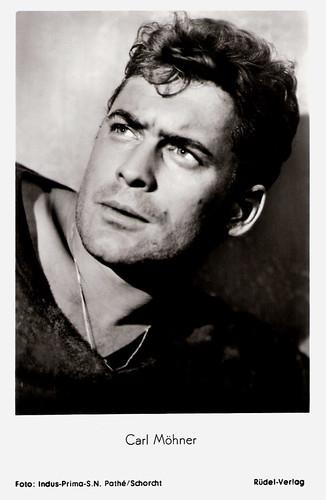
German postcard by Rüdel-Verlag, Hamburg-Bergedorf, no. 1529. Photo: Indus / Prima-S.N. / Pathé / Schorcht. Publicity still for Du rififi chez les hommes / Rififi (Jules Dassin, 1955).
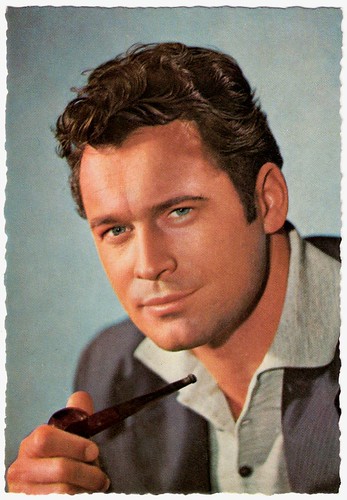
German postcard by WS-Druck, Wanne-Eickel, no. F 65. Photo: Bayer.

German postcard by F.J. Rüdel, Hamburg-Bergedorf. Photo: Gloria.
Carl Martin Rudolf Möhner (sometimes Karl Mohner) was born in Vienna, Austria, in 1921. He visited the theatre school in his hometown in 1937 and went on to work in several German and Austrian theatres. World War II interrupted his career.& After the war, he made his film debut in the drama Vagabunden / Vagabonds (Rolf Hansen, 1949) with Paula Wessely. Next, he appeared in a supporting part in Pünktchen und Anton / Punktchen and Anton (Thomas Engel, 1953), based on the popular children’s book by Erich Kästner.
In 1954, he had his breakthrough in Die Leitze Brücke / The Last Bridge (Helmut Käutner, 1954) filmed in a manner resembling Italian neorealism. The film, starring Maria Schell and Bernhard Wicki, won the International Jury Prize at the Cannes Film Festival and was a commercial success.
During the following years, Möhner had a busy international film career. Among his best known films are the classic French gangster film Du rififi chez les hommes / Rififi (Jules Dassin, 1955) - one of the best ‘perfect robbery goes wrong’ films, and the WW II thriller Sink the Bismarck (Lewis Gilbert, 1960) in which he played the feared Captain Ernest Lindemann of the fabled German battleship Bismarck which had to be destroyed by the British navy.
In Germany, he appeared in Wo die alten Wälder rauschen / Where the Old Forests Rustle (Alfons Stummer, 1956) with Willy Fritsch, Die Geierwally / The Geierwally (Frantisek Cáp, 1956) opposite Barbara Rütting, and Weißer Holunder / Elder White (Paul May, 1957) with Germaine Damar.
In France, he again appeared opposite Jean Servais in another fine thriller by Jules Dassin, Celui qui doit mourir / He Who Must Die (1957). In the UK, he played in the hospital-set drama Behind the Mask (Brian Desmond-Hurst, 1958) with Vanessa Redgrave, and the war drama The Camp on Blood Island (Val Guest, 1958). In Turkey, he wrote and directed Istanbul macerasi / The Istanbul Adventure (1958). He also appeared opposite Jayne Mansfield in the British crime drama The Challenge / It Takes a Thief (John Gilling, 1960).

German collectorscard. Photo: publicity still for Die Letzte Brücke / The Last Bridge (Helmut Käutner, 1954) with Maria Schell.

German postcard by Ufa, no. FK 1723. Photo: Kossler / Ringfilm.
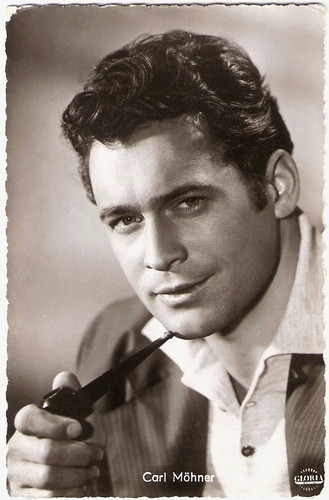
German postcard by Kolibri-Verlag G.m.b.H, Minden/Westf., no. 2309. Photo: Gloria. Publicity still for Wo die alten Wälder rauschen / Where the Old Forests Rustle (1956).
By the early 1960s, Carl Möhner began to dedicate himself to painting. Soon, he had exhibitions in several European cities. In 1963, he won the gold medal in the IX Premio Internationale de Pittura San Vitto Romano. Later on, he was awarded several times more. His style is characterised as ‘simple’ and ‘childlike innocent’.
In Italy, he starred in the Peplum Il Crollo di Roma / The Fall of Rome (Antonio Margheriti, aka Anthony M. Dawson, 1963). Möhner also appeared in three Euro-Westerns: Jim il Primo / The Last Gun (Sergio Bergonzelli aka Serge Bergon, 1964) with Cameron Mitchell, L'uomo dalla pistola d'oro / The Man Who Came to Kill (Alfonso Balcázar, 1965), and 30 Winchester per El Diabolo / 30 Winchesters for El Diablo (Frank G. Carroll, 1967).
He appeared in campy Euro-trash as the shocker Cave of the Living Dead (Akos Rathonyi, 1965), the Sexploitation classic Carmen, Baby (Radley Metzger, 1967), and Nazi-sexploiter Eine Armee Gretchen / She Devils of the SS (Erwin C. Dietrich, 1974) featuring Birgit Bergen.
His final film was the French drama Une Femme à Sa Fenêtre / A Woman at her Window (Pierre Granier-Deferre, 1976) starring Romy Schneider.
Then Carl Möhner retired from the film business and moved to Texas to work on his paintings. Carl Möhner died in McAllen, Texas, from Parkinson's disease. He was 83. Since 1978, Möhner had been married to Wilma Langhamer, and they had two sons, Gunther and Gernot Möhner, who also worked as an actor.
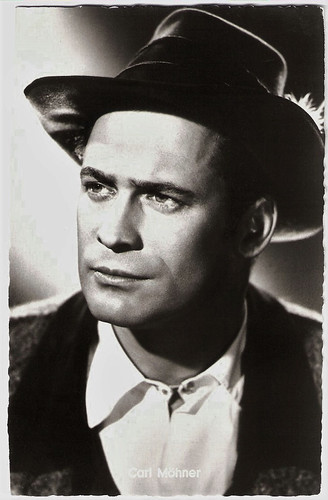
German postcard by Kolibri Verlag G.m.b.H., Minden/Westf., no. 2322. Photo: Ostermayr / Unitas. Publicity still for Der Geierwally / Vulture Wally (Frantisek Cáp, 1956).
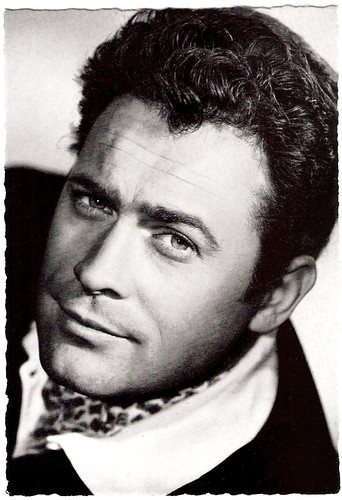
German postcard by WS-Druck, Wanne-Eickel, no. 259. Photo: Bayer / Divina / Gloria.

German postcard distributed by Rodenstock-Sonnenbrille. Photo: Rodenstock / Roth. In his film Weisser Holunder / White Elder (1957), Carl Möhner wore Rodenstock sunglasses.
Sources: Carl Mohner Artist, Tom B. (Westerns All’Italiana), Hal Erickson (AllMovie - Page now defunct), Wikipedia (German and English), and IMDb.
This post was last updated on 5 October 2025.

German postcard by Rüdel-Verlag, Hamburg-Bergedorf, no. 1529. Photo: Indus / Prima-S.N. / Pathé / Schorcht. Publicity still for Du rififi chez les hommes / Rififi (Jules Dassin, 1955).

German postcard by WS-Druck, Wanne-Eickel, no. F 65. Photo: Bayer.

German postcard by F.J. Rüdel, Hamburg-Bergedorf. Photo: Gloria.
Perfect robbery goes wrong
Carl Martin Rudolf Möhner (sometimes Karl Mohner) was born in Vienna, Austria, in 1921. He visited the theatre school in his hometown in 1937 and went on to work in several German and Austrian theatres. World War II interrupted his career.& After the war, he made his film debut in the drama Vagabunden / Vagabonds (Rolf Hansen, 1949) with Paula Wessely. Next, he appeared in a supporting part in Pünktchen und Anton / Punktchen and Anton (Thomas Engel, 1953), based on the popular children’s book by Erich Kästner.
In 1954, he had his breakthrough in Die Leitze Brücke / The Last Bridge (Helmut Käutner, 1954) filmed in a manner resembling Italian neorealism. The film, starring Maria Schell and Bernhard Wicki, won the International Jury Prize at the Cannes Film Festival and was a commercial success.
During the following years, Möhner had a busy international film career. Among his best known films are the classic French gangster film Du rififi chez les hommes / Rififi (Jules Dassin, 1955) - one of the best ‘perfect robbery goes wrong’ films, and the WW II thriller Sink the Bismarck (Lewis Gilbert, 1960) in which he played the feared Captain Ernest Lindemann of the fabled German battleship Bismarck which had to be destroyed by the British navy.
In Germany, he appeared in Wo die alten Wälder rauschen / Where the Old Forests Rustle (Alfons Stummer, 1956) with Willy Fritsch, Die Geierwally / The Geierwally (Frantisek Cáp, 1956) opposite Barbara Rütting, and Weißer Holunder / Elder White (Paul May, 1957) with Germaine Damar.
In France, he again appeared opposite Jean Servais in another fine thriller by Jules Dassin, Celui qui doit mourir / He Who Must Die (1957). In the UK, he played in the hospital-set drama Behind the Mask (Brian Desmond-Hurst, 1958) with Vanessa Redgrave, and the war drama The Camp on Blood Island (Val Guest, 1958). In Turkey, he wrote and directed Istanbul macerasi / The Istanbul Adventure (1958). He also appeared opposite Jayne Mansfield in the British crime drama The Challenge / It Takes a Thief (John Gilling, 1960).

German collectorscard. Photo: publicity still for Die Letzte Brücke / The Last Bridge (Helmut Käutner, 1954) with Maria Schell.

German postcard by Ufa, no. FK 1723. Photo: Kossler / Ringfilm.

German postcard by Kolibri-Verlag G.m.b.H, Minden/Westf., no. 2309. Photo: Gloria. Publicity still for Wo die alten Wälder rauschen / Where the Old Forests Rustle (1956).
Campy euro-trash
By the early 1960s, Carl Möhner began to dedicate himself to painting. Soon, he had exhibitions in several European cities. In 1963, he won the gold medal in the IX Premio Internationale de Pittura San Vitto Romano. Later on, he was awarded several times more. His style is characterised as ‘simple’ and ‘childlike innocent’.
In Italy, he starred in the Peplum Il Crollo di Roma / The Fall of Rome (Antonio Margheriti, aka Anthony M. Dawson, 1963). Möhner also appeared in three Euro-Westerns: Jim il Primo / The Last Gun (Sergio Bergonzelli aka Serge Bergon, 1964) with Cameron Mitchell, L'uomo dalla pistola d'oro / The Man Who Came to Kill (Alfonso Balcázar, 1965), and 30 Winchester per El Diabolo / 30 Winchesters for El Diablo (Frank G. Carroll, 1967).
He appeared in campy Euro-trash as the shocker Cave of the Living Dead (Akos Rathonyi, 1965), the Sexploitation classic Carmen, Baby (Radley Metzger, 1967), and Nazi-sexploiter Eine Armee Gretchen / She Devils of the SS (Erwin C. Dietrich, 1974) featuring Birgit Bergen.
His final film was the French drama Une Femme à Sa Fenêtre / A Woman at her Window (Pierre Granier-Deferre, 1976) starring Romy Schneider.
Then Carl Möhner retired from the film business and moved to Texas to work on his paintings. Carl Möhner died in McAllen, Texas, from Parkinson's disease. He was 83. Since 1978, Möhner had been married to Wilma Langhamer, and they had two sons, Gunther and Gernot Möhner, who also worked as an actor.

German postcard by Kolibri Verlag G.m.b.H., Minden/Westf., no. 2322. Photo: Ostermayr / Unitas. Publicity still for Der Geierwally / Vulture Wally (Frantisek Cáp, 1956).

German postcard by WS-Druck, Wanne-Eickel, no. 259. Photo: Bayer / Divina / Gloria.

German postcard distributed by Rodenstock-Sonnenbrille. Photo: Rodenstock / Roth. In his film Weisser Holunder / White Elder (1957), Carl Möhner wore Rodenstock sunglasses.
Sources: Carl Mohner Artist, Tom B. (Westerns All’Italiana), Hal Erickson (AllMovie - Page now defunct), Wikipedia (German and English), and IMDb.
This post was last updated on 5 October 2025.
No comments:
Post a Comment